This delicious Korean Chicken Dakgalbi recipe is full of tender chicken, a deliciously spicy sauce and lovely veggies. This spicy chicken recipe is a non-traditional take on Dak Galbi you can easily make at home.
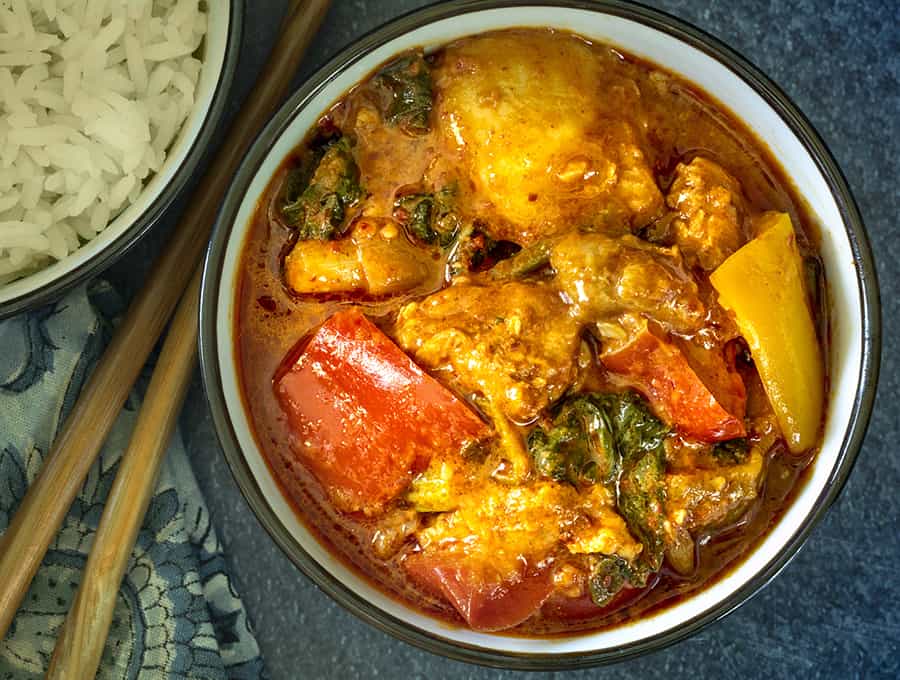
Why You'll Love This Dakgalbi Recipe
- Korean Inspired. Similar to the Dakgalbi you love, but with a twist on ingredients.
- Low Carb. 9 net carbs per serving.
- Delicious. Absolutely packed with flavor.
- High Protein. 35--yes, I said 35-- grams of protein per serving.
What Exactly Is This Korean Chicken Recipe?
It’s called being inspired by dak galbi but actually being too lazy to get all the ingredients like rice cakes, perilla leaves, cabbage, etc. So basically it’s called using up whatever you have in the fridge (which is my typical approach to cooking).
Is this traditional? No, because I used different veggies. Traditional Korean dakgalbi would use cabbage, perilla leaves, etc. But I had veggies leftover from making the Japanese Vegetable Curry, so I decided to use what I had.
You would also have rice cakes in here traditionally, but I didn’t have any….see a theme here? I cook with whatever happens to be around, and you should too!
This deliciously spicy chicken recipe makes a wonderful weeknight dinner option that you can prepare earlier in the day or even marinate the chicken overnight in the fridge. Not only is it quite simple to throw together, but it's fairly low in carbs as well. That means you can enjoy this delicious stovetop meal while still maintaining a keto lifestyle.
What Does Dak Galbi Mean?
Dak means "chicken" and galbi means "rib".
Now this recipe is clearly not made with chicken ribs, but Korean Galbi is often made with beef short ribs. I can assure you that both are equally delicious.
What Is In Dak Galbi?
For The Veggies
- Yellow Peppers
- Mushrooms
- Bok Choy
- Cabbage
- Boneless Skinless Chicken Thighs
For The Sauce
How To Make This Dakgalbi Recipe
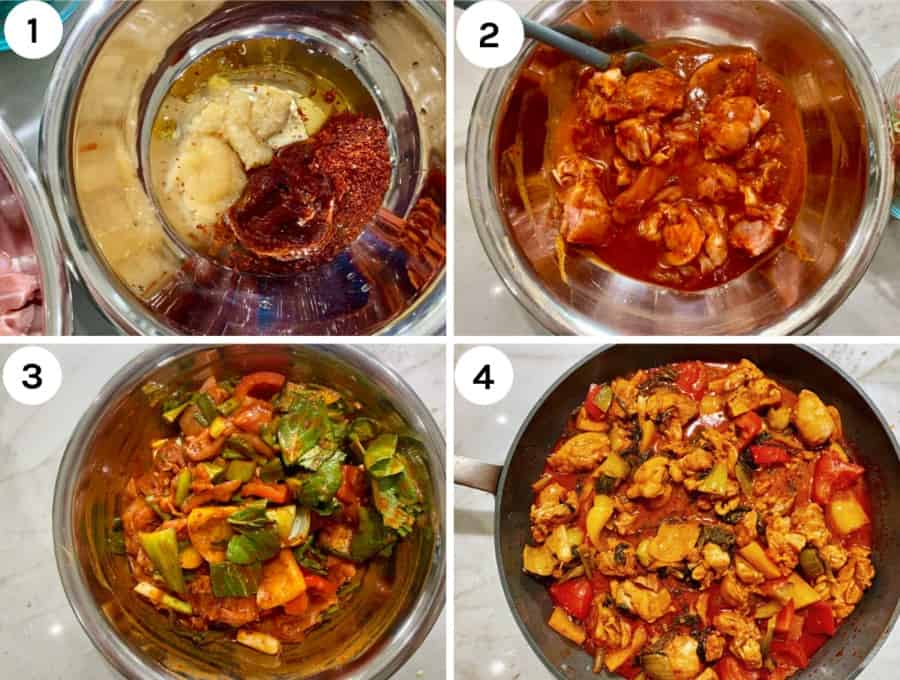
- Mix. In a small bowl, mix together the gochujang, rice vinegar, sesame oil, ginger, garlic, gochugaru and salt.
- Pour. Place the chicken in a large bowl. Pour over the sauce and mix everything well.
- Add in the veggies. Accept that your spatula won’t do the trick. Wash your hands and use your clean hands to mix everything together. I like to squish the veggies a little to macerate them so they take on more of the marinade.
- Marinate. Let this rest for up to 30 minutes or for several hours in the refrigerator.
- Heat. Heat up a 12-inch cast-iron pan or a nonstick pan on high heat.
- Cook. When the pan is hot, add the chicken and veggies. Stir and then reduce heat to medium. Cover and cook for 15 minutes stirring halfway through until the chicken is cooked.
- Serve. Serve with rice, lettuce leaves, or swiss chard leaves for wrapping.
How Do You Eat Dakgalbi?
If you went out to eat this dak-galbi Korean chicken recipe, after the chicken and veggies were cooked, you’d get some steamed rice which would be heated up in the fond that was left from cooking the chicken and veggies. So you’d have this delicious, spicy fried rice like thing to share. Or not share.
A lower carb option is to wrap it in perilla leaves, but since my little Texas town has nary a perilla leaf in sight, I wrap it in swiss chard leaves or lettuce leaves.
How Long Can You Marinate Chicken?
For this Dakgalbi recipe, I recommend marinating the chicken from 30 minutes to a few hours in the refrigerator. According to the USDA you can safely marinate chicken for up to two days in the fridge, but keep in mind that acidic marinades can actually make meat tougher the longer it marinates.
What Do You Use Gochujang For?
Aside from using it for meat dishes like this delicious Korean chicken recipe, there are plenty of delicious ways to enjoy Gochujang. You can whip up a sauce like my Gochujang Mayonnaise, use it to coat this delightfully spicy Air Fryer Korean Chicken Wings, or even mix it up and use it as a sauce substitute for my Keto Buffalo Cauliflower recipe. This stuff is so good and the possibilities are endless, so go wild and let me know how you decided to use it in the comments!
Korean Chicken Tips And Tricks
- In a restaurant, there would be a ginormous pan to cook this thing. I am not a restaurant, and I don’t have a ginormous thing. So you have two choices:
- Make this in 2 batches in a 12-inch skillet.
- Or you could cook it on this electric griddle, which is fun, but you don’t get the same fond thing going in which to mix up the rice. You can also use this griddle to make my Dae Ji Bulgogi or tortillas or chapati for my Frankies recipe.
- The final texture of this dish is midway between crispy and soupy. Lots of fond, but not lots of sauce. Just enough to soak up that rice!
- If you don’t have gochugaru, use a little cayenne pepper. Gochugaru is a LOT less spicy than cayenne, so don’t directly swap one for one.
- This dish tastes fabulous as leftovers, but due to the delicate veggies, it won’t freeze very well.
- Other veggies to use: shredded cabbage, sweet potatoes (which will take longer to cook through) or shredded carrots.
More Korean Recipes
- Air Fryer Beef Bulgogi - This dish uses such basic ingredients yet comes out tasting so very good.
- Yukgaejang - A great keto beef stew recipe that's just a little bit out of the ordinary.
- Korean Cucumber Salad - A wonderful vegan, keto and simple cucumber salad recipe.
- Beef Bulgogi Burgers - A Korean twist on burgers.
- Air Fryer Korean Tacos - Crazy easy to make, and you're going to love the flavors!
- Air Fryer Dae Ji Bulgogi - A wonderful way to get a savory, umami, spicy Korean grilled pork dish.
- Korean Galbi - A super yummy Korean short rib recipe.
- Pressure Cooker Dae Ji Bulgogi - Make flavorful and tender Korean pork in your Instant Pot.
- Kimchi Stew - spicy and tangy with incredible flavors!
- Korean Beef Bowl- the Instant Pot recipe you've been waiting for.
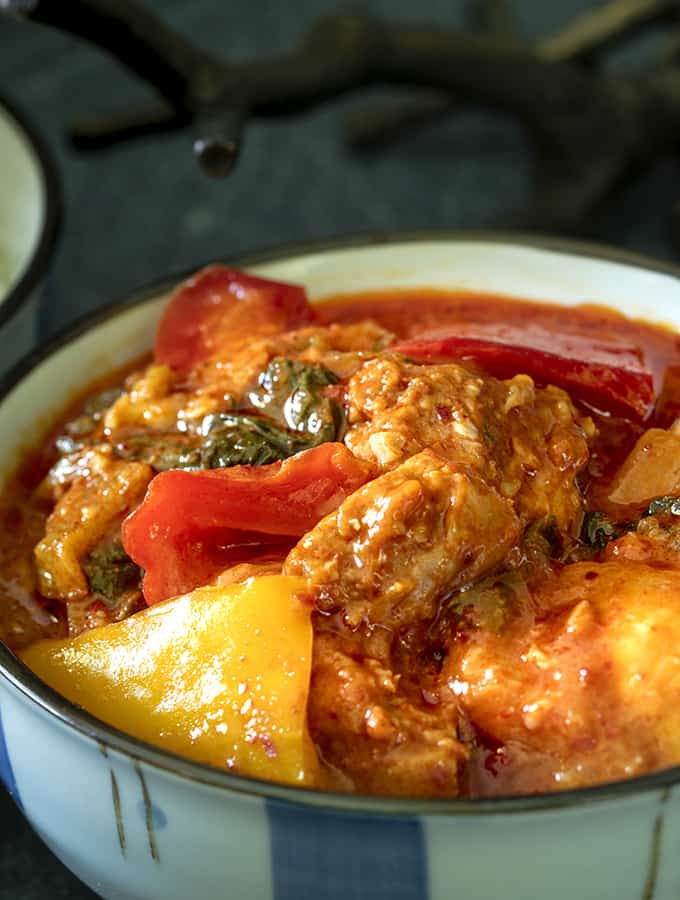
So put a little kick in your dinner tonight and make this wonderfully spicy Dakgalbi Korean Chicken recipe. Make sure to share this recipe with your friends on Pinterest and Facebook so they can enjoy it as well!
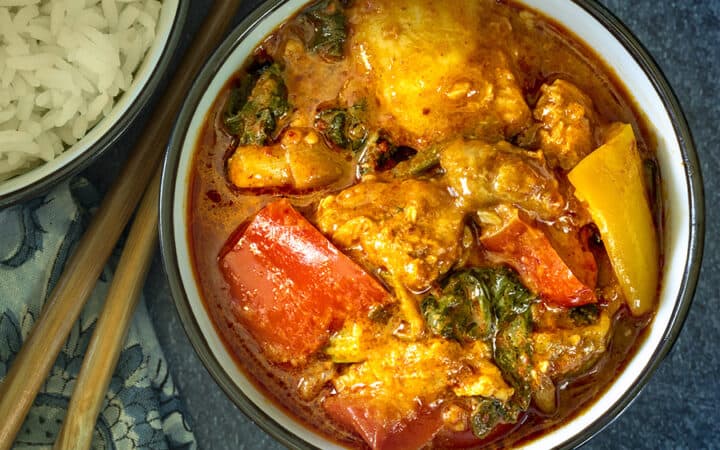
Equipment
Ingredients
4 Cups Assorted Vegetables Like:
- 1 cup Yellow Peppers, chopped
- 1 cup Mushrooms, cut into quarters
- 1 cup Bok Choy, chopped
- 1 cup Cabbage, roughly chopped
- 1.5 pounds Boneless Skinless Chicken Thighs, cut into 2-inch pieces
For The Sauce
- 1/4 cup Gochujang
- 1/4 cup Rice Vinegar
- 2 tablespoons Sesame Oil
- 1 tablespoon Minced Garlic
- 1 tablespoon Minced Ginger
- 2 teaspoons Gochugaru, or 1/2 teaspoon cayenne
- 1 teaspoon Kosher Salt
Instructions
- In a small bowl, mix together the gochujang, rice vinegar, sesame oil, ginger, garlic, gochugaru and salt.
- Place the chicken in a large bowl. Pour over the sauce and mix everything well.
- Add in the veggies. Accept that your spatula won’t do the trick. Wash your hands and use your clean hands to mix everything together. I like to squish the veggies a little to macerate them so they take on more of the marinade.
- Let this rest for up to 30 minutes or for several hours in the refrigerator.
- Heat up a 12-inch cast-iron pan or a nonstick pan on high heat.
- When the pan is hot, add the chicken and veggies. Stir and then reduce heat to medium. Cover and cook for 15 minutes stirring halfway through until the chicken is cooked.
- Serve with rice, lettuce leaves, or swiss chard leaves for wrapping.
Korean Chicken Tips And Tricks
- In a restaurant, there would be a ginormous pan to cook this thing. I am not a restaurant, and I don’t have a ginormous thing. So you have two choices:
- Make this in 2 batches in a 12-inch skillet.
- Or you could cook it on this electric griddle, which is fun, but you don’t get the same fond thing going in which to mix up the rice. You can also use this griddle to make my Dae Ji Bulgogi or tortillas or chapati for my Frankies recipe.
- The final texture of this dish is midway between crispy and soupy. Lots of fond, but not lots of sauce. Just enough to soak up that rice!
- If you don’t have gochugaru, use a little cayenne pepper. Gochugaru is a LOT less spicy than cayenne, so don’t directly swap one for one.
- This dish tastes fabulous as leftovers, but due to the delicate veggies, it won’t freeze very well.
- Other veggies to use: shredded cabbage, sweet potatoes (which will take longer to cook through) or shredded carrots.
Get support & connect with our community on Facebook!
Nutrition
Originally Published April 20, 2020
Don't forget to check out my other Keto cookbooks.
Keto Instant Pot, Keto Fat Bombs, Sweets, & Treats, and Easy keto in 30 minutes.




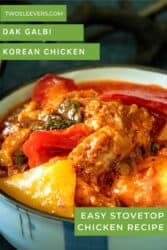
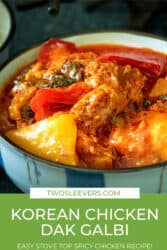

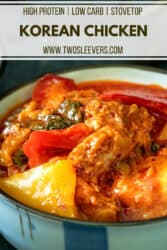
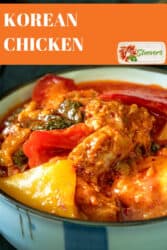
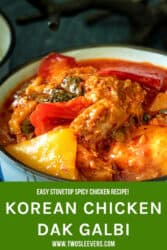

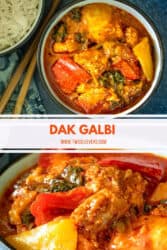
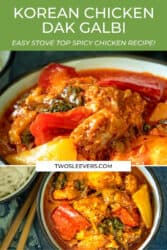
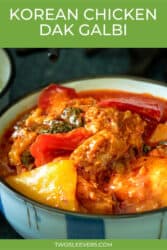
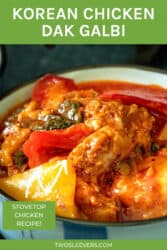
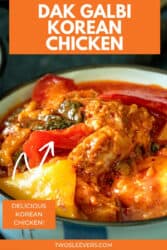
Keri Lothian
That is the best blog for anyone who desires to find out about this topic. You realize so much its virtually laborious to argue with you (not that I truly would want…HaHa). You definitely put a new spin on a subject thats been written about for years. Nice stuff, just nice!
Jane Ormrod
I made this for my son and it tasted great. He's a Korean Spicy Chicken connoisseur and he gave me two thumbs up!
I'm wondering ... does it work with a Keto diet? I wanted to have more than just a taste, but I wasn't sure.
Wonderful, fast Korean food. What a great website!
URVASHI PITRE
Yes so you’d substitute swerve or Truvia instead of sugar but other than that, it would totally work
Lauri Eide
What would be a good substitute for mushrooms? I'm saving this recipe to try when I have gotten all the ingredients together, sounds great!
URVASHI PITRE
You could Omit those or whatever vegetable you like. I’d try bok choy and green onions
Jenny
Easy and super delicious. I marinated about 7 hours. This is a keeper!
Linda
Can you make the korean dark galbi in the instant pot? I love your recipes!